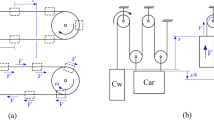Abstract
This paper presents a discretization procedure for the flexible multibody modeling of reeving systems. Reeving systems are assumed to include a set of rigid bodies connected by wire ropes using a set of sheaves and reels. The method is capable to model the deformation of the varying-length wire-rope spans. Wire ropes are assumed to deform axially, transversally and in torsion. This paper shows the capability of the presented method to model transverse vibrations. The discretization procedure uses a combination of absolute position coordinates, relative-transverse deformation coordinates and longitudinal material coordinates. Each wire-rope span is modeled using a single two-noded element under an arbitrary Lagrangian–Eulerian approach. The discretization method is validated using analytical and numerical reference solutions found in the literature that describe the dynamics of varying-length strings. In addition, the dynamics of a three-dimensional tower crane is simulated.















Similar content being viewed by others
References
Pevrot, A.H., Goulois, A.M.: Analysis of cable structure. Comput. Struct. 10(5), 805–813 (1979)
Nawrocki, A., Labrosse, M.: Finite element model for simple straight wire rope strands. Comput. Struct. 77(4), 345–359 (2000)
Costello, G.A.: Theory of Wire Rope. Springer, New York (1990)
Feyrer, K.: Wire Ropes. Tension, Endurance, Reliability. Springer, Berlin (2007)
Kamman, J., Huston, R.: Multibody dynamics modelling of variable length cable systems. Multibody Syst. Dyn. 5(3), 211–221 (2001)
Rouvinen, A., Lehtinen, T., Korkealaakso, P.: Container gantry crane simulator for operator training. Proc. Inst. Mech. Eng., Proc., Part K, J. Multi-Body Dyn. 219(4), 325–336 (2005)
Lugrís, U., Escalona, J.L., Dopico, D., Cuadrado, J.: Efficient and accurate simulation of the rope–sheave interaction in weight-lifting machines. Proc. Inst. Mech. Eng., Proc., Part K, J. Multi-Body Dyn. 225(4), 331–343 (2011), Special Issue Paper
Lugrís, U., Naya, M.A., Pérez, J.A., Cuadrado, J.: Implementation and efficiency of two geometric stiffening approaches. Multibody Syst. Dyn. 20(2), 147–161 (2008)
Sugiyama, H., Escalona, J.L., Shabana, A.A.: Formulation of three-dimensional joint constraints using the absolute nodal coordinates. Nonlinear Dyn. 31(2), 167–195 (2003)
Sugiyama, H., Mikkola, A.M., Shabana, A.A.: A non-incremental nonlinear finite element solution for cable problems. J. Mech. Des. 125(4), 746–756 (2003)
Gerstmayr, J., Shabana, A.A.: Analysis of thin beams and cables using the absolute nodal co-ordinate formulation. Nonlinear Dyn. 45, 109–130 (2006)
Dufva, K., Kerkkänen, K., Maqueda, L.G., Shabana, A.A.: Nonlinear dynamics of three-dimensional belt drives using the finite-element method. Nonlinear Dyn. 48(4), 449–466 (2007)
Kerkkänen, K., García-Vallejo, D., Mikkola, A.: Modeling of belt-drives using a large deformation finite element formulation. Nonlinear Dyn. 43(3), 239–256 (2006)
Stangl, M., Gerstmayr, J., Irschik, H.: A large deformation finite element for pipes conveying fluid based on the absolute nodal coordinate formulation. In: ASME 2007 International Design Engineering Technical Conferences and Computers and Information in Engineering Conference (2007)
Pechstein, A., Gerstmayr, J.: A Lagrange–Eulerian formulation of an axially moving beam based on the absolute nodal coordinate formulation. Multibody Syst. Dyn. 30(3), 343–358 (2013)
Hong, D., Ren, G.: A modeling of sliding joint on one-dimensional flexible medium. Multibody Syst. Dyn. 26(1), 91–106 (2011)
Escalona, J.L.: An arbitrary Lagrangian–Eulerian discretization method for modeling and simulation of reeving systems in multibody dynamics. Mech. Mach. Theory 112, 1–21 (2017)
Irschik, H., Holl, H.J.: The equations of Lagrange written for a non-material volume. Acta Mech. 153(3), 231–248 (2002)
Butikov, E.I.: Misconceptions about the energy of waves in a strained string. Phys. Scr. 86(3), 035403 (2012), 7 pp.
Wehage, R.A., Haug, E.J.: Generalized coordinate partitioning for dimension reduction in analysis of constrained dynamic systems. J. Mech. Des. 104(1), 247–255 (1982)
Balazs, N.L.: On the solution of the wave equation with moving boundaries. J. Math. Anal. Appl. 3(3), 472–484 (1961)
Acknowledgements
This study is partly funded by the Academy of Finland, with decision no. 285065.
Author information
Authors and Affiliations
Corresponding author
Appendix A: Generalized inertia vector based on simplified velocity expression
Appendix A: Generalized inertia vector based on simplified velocity expression
The generalized momentum is obtained as the partial derivative of the expression of the kinetic energy given in Eq. (16) with respect to the generalized velocities, as follows:
The first term in Lagrange equations can be obtained:
where the terms on the r.h.s. which are proportional to the generalized accelerations are already accounted for in the generalized inertia force vector \(\mathbf{M}\ddot{\mathbf{q}}\). The second term in Lagrange equations can be obtained:
The generalized quadratic-velocity inertia vector \(\mathbf{Q} _{v}\) collects all inertia terms which are not proportional to the generalized accelerations, as follows:
Substituting Eqs. (58), (57) and (18) into (59) and rearranging yields
Rights and permissions
About this article
Cite this article
Escalona, J.L., Orzechowski, G. & Mikkola, A.M. Flexible multibody modeling of reeving systems including transverse vibrations. Multibody Syst Dyn 44, 107–133 (2018). https://doi.org/10.1007/s11044-018-9619-6
Received:
Accepted:
Published:
Issue Date:
DOI: https://doi.org/10.1007/s11044-018-9619-6




